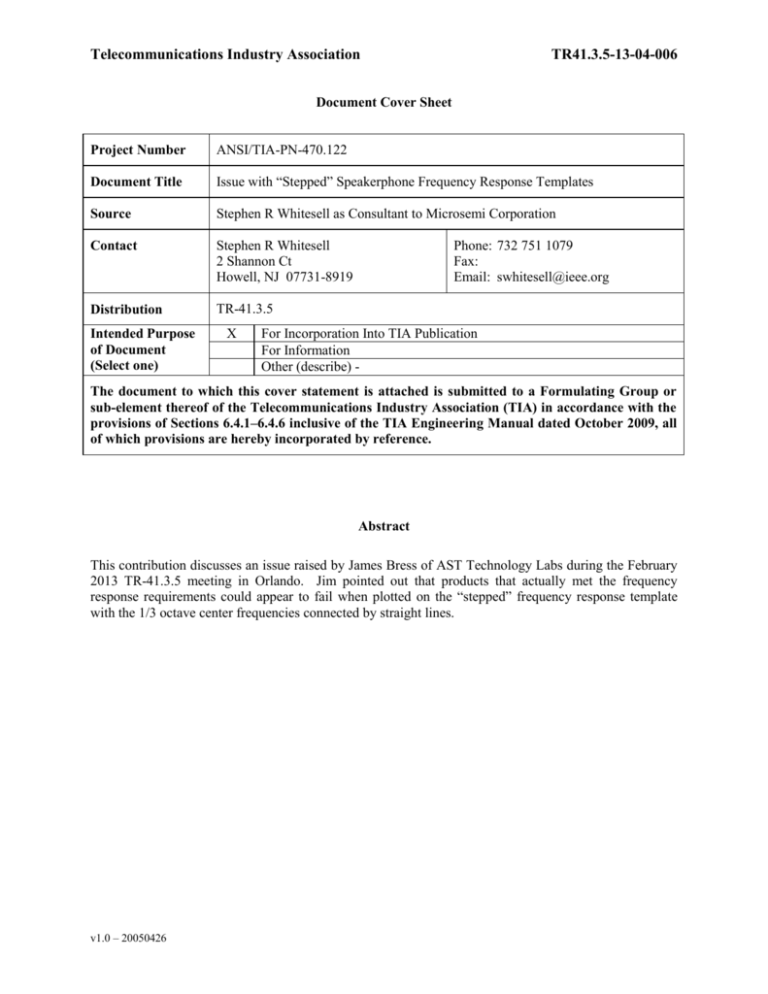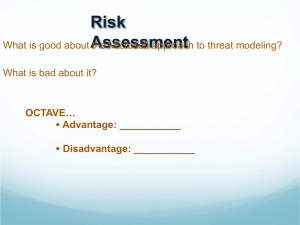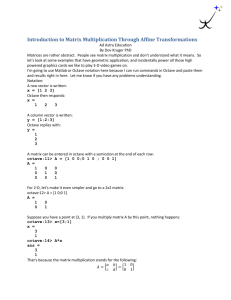TR41.3.5-13-04-006 - Telecommunications Industry Association
advertisement

Telecommunications Industry Association TR41.3.5-13-04-006 Document Cover Sheet Project Number ANSI/TIA-PN-470.122 Document Title Issue with “Stepped” Speakerphone Frequency Response Templates Source Stephen R Whitesell as Consultant to Microsemi Corporation Contact Stephen R Whitesell 2 Shannon Ct Howell, NJ 07731-8919 Distribution TR-41.3.5 Intended Purpose of Document (Select one) X Phone: 732 751 1079 Fax: Email: swhitesell@ieee.org For Incorporation Into TIA Publication For Information Other (describe) - The document to which this cover statement is attached is submitted to a Formulating Group or sub-element thereof of the Telecommunications Industry Association (TIA) in accordance with the provisions of Sections 6.4.1–6.4.6 inclusive of the TIA Engineering Manual dated October 2009, all of which provisions are hereby incorporated by reference. Abstract This contribution discusses an issue raised by James Bress of AST Technology Labs during the February 2013 TR-41.3.5 meeting in Orlando. Jim pointed out that products that actually met the frequency response requirements could appear to fail when plotted on the “stepped” frequency response template with the 1/3 octave center frequencies connected by straight lines. v1.0 – 20050426 Telecommunications Industry Association TR41.3.5-13-04-006 Background The speakerphone response templates shown in the initial draft of ANSI/TIA-PN-470.122 (contribution TR41.3.5-13-02-005-MR2) use the same “stepped” approach as in published speakerphone standards ANSI/TIA-470.120-C and TIA-920.120-A. They actually come from the latter document. These templates were plotted in steps to emphasize the fact that the requirements apply to the response averaged over 1/3 octave bands. During the TR-41.3.5 discussion in the February meeting, there was agreement that the send and receive frequency response data is either (1) to be measured in 1/3 octave bands or (2) have band averaging applied to determine the 1/3 octave levels if measured in narrower (e.g., 1/12 octave bands). James Bress of AST Technology Labs pointed out that most test equipment determines the 1/3 octave levels correctly and then plots them as “dots” at each 1/3 octave center frequency connected by lines. In doing so, it is possible for a line connecting the levels at adjacent 1/3 octave frequencies to cross the corner of a “step” and give the appearance of a failure even though the two levels actually meet the requirement. Illustration for Send Frequency Response The following figure illustrates how this could happen for a send measurement. An arbitrarily drawn response “curve” is shown in red and connects values at the center frequencies of 1/3 octave bands that are all within response limits. The data points were chosen to be near the lower limit at low frequencies and near the upper limit at high frequencies so that it is not possible to get a better “fit” by shifting the template up or down. Specific data points in the mid frequencies are not relevant to this discussion and were omitted. Note how the curve “nicks” the corners of the stepped template (shown in gray). However, if the template is drawn by connecting the center frequencies for each 1/3 octave band (shown in black), then the response curve is shown within limits, thus avoiding the appearance of failures. Send Frequency Response Template Problem 20 Relative Response (dB) 10 0 -10 -20 100 1000 Frequency (Hz) Page 2 10000 Telecommunications Industry Association TR41.3.5-13-04-006 During the discussion at the February meeting, there seemed to be agreement to expand the table listing the limits to include values for each 1/3 octave center frequency accompanied by a note making a point that the limit applies to the average value of the signal in the 1/3 octave band whose center frequency is shown. There also seemed to be agreement to show the template as lines connecting the 1/3 octave center frequency limits (i.e. the black line template in the above figure). Taking this approach results in a template with slightly “wavy” lines for the upper limit as shown in the figure below (gray curve). This is apparently an artifact from the original decision to show the template in steps and choosing to keep the step sizes in whole dBs. I am proposing to “straighten” the limit curves by adjusting the limits slightly (black curve). The table following the figure provides the original 1/3 octave limits that were taken from TIA-920.120-A (list expanded to show limit for each individual 1/3 octave frequency) and the proposed modified limits. Two proposals are included for the low frequency upper limit. One keeps the same endpoint value at 100 Hz and the other minimizes the average difference between the original and proposed values. The modified values are shown in red, with the additional modified values for the alternative low frequency proposal shown in blue. There are no changes to the lower limit. Send Frequency Response Template Proposal 20 Relative Response (dB) 10 0 -10 -20 100 1000 Frequency (Hz) Page 3 10000 Telecommunications Industry Association TR41.3.5-13-04-006 Send Frequency Response Limits 1/3 Octave Center Frequency (Hz) TIA-920.120-A Lower Limit (dB) Upper Limit (dB) Proposal Lower Limit (dB) Upper Limit (dB) Alternate Proposal Lower Limit (dB) Upper Limit (dB) 100 2.0 2.0 0.0 125 2.0 2.5 1.0 160 2.0 3.0 2.0 200 2.0 3.5 3.0 250 -8.0 4.0 -8.0 4.0 -8.0 4.0 315 -6.0 4.0 -6.0 4.0 -6.0 4.0 400 -4.0 4.0 -4.0 4.0 -4.0 4.0 500 -4.0 4.0 -4.0 4.0 -4.0 4.0 630 -4.0 4.0 -4.0 4.0 -4.0 4.0 800 -4.0 4.0 -4.0 4.0 -4.0 4.0 1000 -4.0 4.0 -4.0 4.0 -4.0 4.0 1250 -4.0 5.0 -4.0 4.5 -4.0 4.5 1600 -4.0 5.0 -4.0 5.0 -4.0 5.0 2000 -4.0 6.0 -4.0 5.5 -4.0 5.5 2500 -4.0 6.0 -4.0 6.0 -4.0 6.0 3150 -4.0 7.0 -4.0 6.5 -4.0 6.5 4000 -6.0 7.0 -6.0 7.0 -6.0 7.0 5000 -8.0 6.0 -8.0 6.0 -8.0 6.0 6300 4.0 5.0 5.0 8000 4.0 4.0 4.0 Receive Frequency Response Proposal Similar considerations apply for the receive frequency response. Although no arbitrary response curve is included, the first figure below shows the stepped response template taken from TIA-920.120-A (gray curve) and the corresponding template with the 1/3 octave center frequency limits connected with straight lines (black curve). The second figure below shows a proposal to “straighten the limit lines by slightly modifying the 1/3 octave limit values. Finally, the table following the second figure provides the original limit values taken from TIA-920.120-A and the proposed modified limits with the modified values shown in red. Page 4 Telecommunications Industry Association TR41.3.5-13-04-006 Recieve Frequency Response Template Problem 20 Relative Response (dB) 10 0 -10 -20 100 1000 Frequency (Hz) 10000 Recieve Frequency Response Template Proposal 20 Relative Response (dB) 10 0 -10 -20 100 1000 Frequency (Hz) Page 5 10000 Telecommunications Industry Association TR41.3.5-13-04-006 Receive Frequency Response Limits 1/3 Octave Center Frequency (Hz) TIA-920.120-A Lower Limit (dB) Upper Limit (dB) Proposal Lower Limit (dB) Upper Limit (dB) 100 4.0 3.0 125 4.0 3.5 160 4.0 4.0 200 4.0 4.5 250 -9.0 5.0 -9.0 5.0 315 -7.0 5.0 -7.0 5.0 400 -5.0 5.0 -5.0 5.0 500 -5.0 5.0 -5.0 5.0 630 -5.0 5.0 -5.0 5.0 800 -5.0 5.0 -5.0 5.0 1000 -5.0 5.0 -5.0 5.0 1250 -5.0 5.0 -5.0 5.0 1600 -5.0 5.0 -5.0 5.0 2000 -5.0 5.0 -5.0 5.0 2500 -5.0 5.0 -5.0 5.0 3150 -6.0 5.0 -5.5 5.0 4000 -6.0 5.0 -6.0 5.0 5000 -9.0 4.0 -9.0 4.5 6300 4.0 4.0 8000 4.0 3.5 Note to Accompany Tables The following text is suggested as a note to follow both the send and receive frequency response limit tables: Note: The values shown apply to the signal level averaged over the 1/3 octave band associated with the given center frequency. If the measurement is made using bands narrower than 1/3 octave, see IEEE Std 269 for determining the frequencies of the band edges and, hence, the sub-bands to be used in determining the average signal level to be associated with each 1/3 octave band center frequency. Page 6









